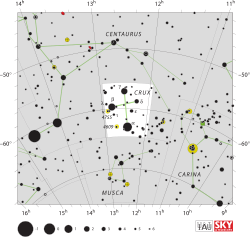Crux
constellation in the southern celestial hemisphere From Wikipedia, the free encyclopedia
Remove ads
Crux, commonly known as the Southern Cross, is a constellation that can be seen by people in the Southern Hemisphere. Its four brightest stars are in the shape of a cross. The name Crux is the Latin word for a cross. It is a small constellation, but the four main stars are bright, so the cross shape is easily seen in the sky. Each of the four stars has an apparent visual magnitude brighter than +2.8. The four stars point approximately in the directions of north, south, east and west.

Crux was first described by the Italian navigator Andrea Corsali in 1515.[1] In the past, sailors used Crux to help with navigating across oceans.
The Southern Cross is used as a symbol in many Southern Hemisphere countries and states. It appears on the flags of Australia, Brazil, New Zealand, Papua New Guinea and Samoa.
It was used on the flag flown by miners in Ballarat, Victoria, during the 1854 rebellion known as the Eureka Stockade. The flag has been used as a symbol of protest in Australia since then.
Remove ads
Related pages
References
Wikiwand - on
Seamless Wikipedia browsing. On steroids.
Remove ads

